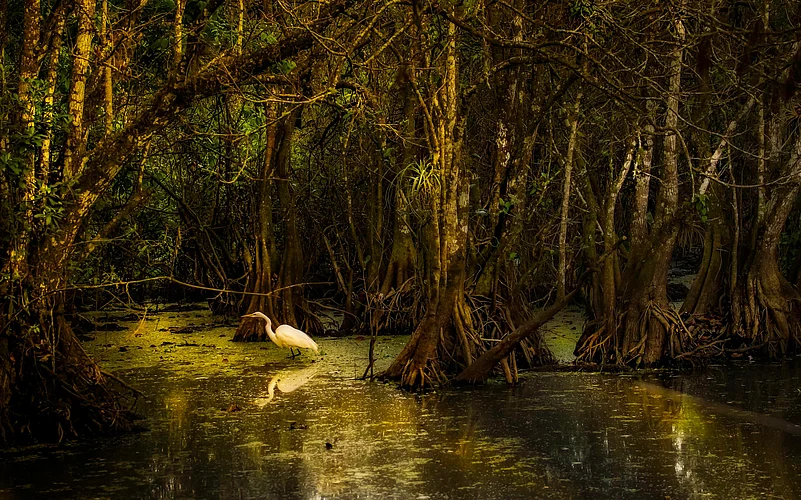Mangroves are salt-tolerant plants that are known to thrive in tropical and sub-tropical intertidal regions around the world. These plants serve as a natural barrier against ocean dynamics along coastlines. Mangroves have undergone several adaptations to survive in waterlogged soils, high salinity, and amid the natural threats of cyclonic storms and tidal surges.
This particular plant species is among the most important ecosystems supporting thousands of plants and animals while servicing the needs of local populations residing in coastal region around the world. For instance, large populations, primarily in rural areas, are said to rely on mangrove ecosystems for various livelihood activities that depend on biomass resources.
In recent years, the role of mangroves in carbon storage and fisheries production has gained recognition among the scientific community and policymakers. According to some estimates, mangroves sequester approximately 3 per cent of the world’s tropical forest carbon despite occupying less than 1 per cent of the total tropical forest area.
Mangroves in India: A Status Report
As per the latest Status of Forest Report (SOFR), India's mangrove forests have the world’s highest recorded biodiversity, supporting as many as 4,107 species of flora and fauna. Mangrove habitat in the country are broadly found in three main regions: (i) the east coast, (ii) the west coast, and (iii) the islands of Andaman and Nicobar, and along with the Lakshadweep atoll.
The highest mangrove diversity in the country is found in the Andaman and Nicobar islands, home to a host of unique mangrove species including Rhizophora lamarckii, Lumnitzera littorea, Sonneratia ovata, S. lanceolata, S. urama and S. gulngai. The Sundarbans in India also has rich mangrove cover, constituting around two-fifths of the region’s overall surface area. The region derives its name from the splendid-looking ‘Sundari’ species (Heritiera fomes), a native mangrove species faced with the looming threat of extinction. The Sundari species and Sonneratia griffithii found in the Andamans are among the 11 species listed on the IUCN red list.
As of 2021, India's total mangrove cover extends over an area of 4,992 square kilometers, accounting for 0.15 per cent of the country's land area. Of the overall mangrove cover in the country, 57 per cent is said to be along the east coast (Bay of Bengal), 31 per cent along the west coast (Arabian Sea) and 12 per cent in the Andaman and Nicobar islands.
Although natural regeneration has led to an increase of mangrove cover in states like Andhra Pradesh and Maharashtra, on an overall basis there has been a decline in mangrove cover in the country, in comparison to the 2021 assessment. The report also pointed out a prominent decrease of mangrove cover in Gujarat.
Challenges and Conservation Measures
Despite sustained efforts towards mangrove protection, rapid coastal development and climate change have significantly contributed to mangrove degradation, noted the latest SOFR assessment.
Going by the global consensus, changing land-use patterns and coastal erosion have been identified as the primary drivers of mangrove loss. Erosion, for instance, has been linked to the disappearance of 927.87 square kilometres of mangroves between 2000 and 2016.
As a result, India has been focusing on improving plantation techniques, conservation measures, management practices and resources mobilization to tackle the challenge of mangrove degradation and loss.
Policy measures such as the Coastal Regulation Zone (CRZ) Notification under the Environment (Protection) Act of 1986, which designates mangroves as ecologically sensitive areas, the Indian Forest Conservation Act of 1980, and the Wildlife (Protection) Act of 1972 have been among the contributing factors in this regard.
A series of concerted measures have also been undertaken to ensure the ecological well-being of mangroves in the country. In Gujarat, particularly, restoration work has managed to revive a total of 490 sq km of mangrove area through public-private partnerships and government support.
The Integrated Coastal Zone Management (ICZM) project has undertaken afforestation measures in Gujarat, Odisha and West Bengal. Maharashtra, Kerala and Odisha have introduced local initiatives like the "Mangrove Cell" and the Kannur Mangrove Mission to preserve mangroves in their respective regions. Local communities have also been mobilised to participate in the conservation and protection of mangroves.
Key mangrove areas in the Sunderbans, Bhitarkanika (Odisha), and Pichavaram (Tamil Nadu) have been designated as Ramsar Sites. India is a party to the Ramsar Convention, which recognizes the importance of wetlands including mangroves and commits to their conservation.






























